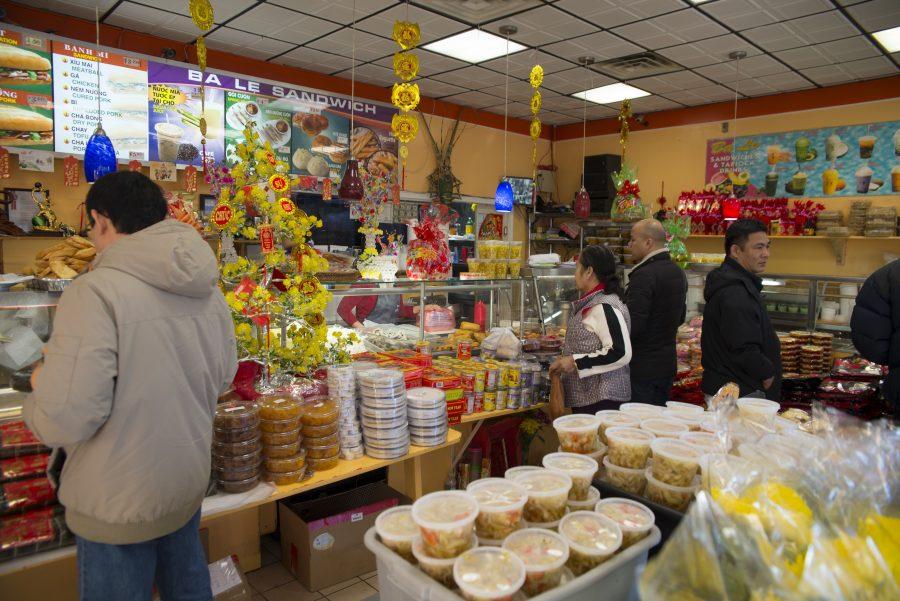The restaurants along the streets of Dorchester, Mass. are a constant reminder of the neighborhood’s multiculturalism. For the prospective eater, they provide a variety of options to choose from. Curious to try food that you have little experience with? Craving that specific something to hit the spot? This article series is devoted to finding great ethnic food in Dorchester, cross-referencing sources and exploring the menu so you don’t have to. More than that, it is about sharing the personal anecdotes and culture of the people behind the meal.
Pho 2000 is located at 198 Adams St. It has warm lighting and walls covered in mirrors, with inlets containing growing bamboo plants. This cozy establishment is appropriate for different dining situations, from reading a book with a steaming bowl of soup and a cup of tea, to large parties eating family-style, distributing food from plates in the center of the round tables.
Explicit in the name, the menu boasts a list of the famous Vietnamese soup, phở. A great choice is the bò kho, with tender cubes of beef, or the phở gà, with strips of white meat chicken. Both had a mound of rice noodles hiding at the bottom of the delicious broth with scallions, onions, and cilantro. “We boil the beef for 12 hours [to give the broth the flavor],” said Julie Yu, 24-year-old Dorchester resident, who doubles as cook and server. Bean sprouts, sliced limes, basil leaves, and chile come with the meal to be added to the soup at the patron’s discretion. The sprouts add textural range to the phở.
When asked what her favorite dish in the restaurant was, Yu, an employee of six years, said, “Phở 2000.” This signature soup is an extra-large portion of their đặc biệt. Note, extra-large means a bowl with the circumference of a basketball. Floating among other cuts of beef were circular wafers of steak, partially raw when approaching the table, but in minutes had cooked in the broth. This is a fresh, fun, and sometimes interactive aspect of a Vietnamese restaurant: The meal’s preparation can occur tableside.
One menu option well-lauded by the voices of patrons and Yelpers alike, is the bò 7 món or seven courses of beef. For one of the courses, the server brings over a little hot plate so you can cook your beef yourself, and for another course, nigh boiling water is served for the same reason. At $30 for two people, the meal has a lot of value.
While I only saw others eat bò 7 món, I did try cá nướng, a fried catfish about two-feet long. The catfish skin was crispy, and the slight char added to the flavor. The moist meat underneath broke to flakes. With the fish came a plate of mint, basil, cucumbers, sliced apples, and bean sprouts, and another with vermicelli rice noodles. A bowl of hot water and a stack of rice papers were placed in front of us. The proper way to eat the dish is to dip the paper, and roll a spring roll with the insides of your choosing. The cá nướng was $46, but it is enough to feed four, if not more people. During my different visits, there was always at least one family sharing it. Yu said that mealtime is important to the Vietnamese family and its cohesion.
The menu also has a number of meat, vegetable, and fried rice combos, as well as salads, so there is something for everybody. The appetizers I tried were spring rolls, fried spring rolls, and homemade crab rangoon — all great and portioned well. Worth mentioning, is that the spring rolls and the phở are tasty and satisfying, yet still light. Yu prided Vietnamese food on the deft use of fresh vegetables and herbs.
Jennifer Nguyen, the owner of Banh Mí Ba Le, reiterated this, saying that Vietnamese food is healthy and nutritious, and for the most part, uses little oil. Located on 1052 Dorchester Ave., her business was opened in 1996 and in 2006. Due to popular demand, they opened up another location in Quincy, Mass.
When asked how she beats out the nearby competition, she said, “Our hours. We open early at 5 a.m.,” and she pointed to the menu on the wall, “The sandwiches. People love them.” As a result of French occupation, Vietnamese cuisine is a sort of naturally occurring Asian fusion, incorporating both baguettes and pâté into their sandwich style. “Over there,” said Nguyen, pointing to a dark room off to the side. “That is where I make the bread… it’s not too crunchy, not too soft — in the middle.”
I tried three of the sandwiches, the đặc biệt, the thịt nướng, and the xíu mại. My favorite was the thịt nướng which had sweet BBQ pork, but the đặc biệt, which contained a couple different meats, two of which I could identify as ham and a pâté, and the xíu mại, which had soft Vietnamese meatballs, were delicious. But these sandwiches are all about the balance of flavor — the saltiness of the meat, the richness of the bread, the sweetness of the pickled daikon and carrot, jalepeno’s heat, and of course, the cilantro. “80 percent of Vietnamese cooking uses cilantro,” says Nguyen, only half-joking. Cilantro, along with lemongrass, are crucial to the Vietnamese flavor profile.
The kicker: The sandwiches only cost $3.50. It’s no wonder that some University of Massachusetts Boston students have already discovered her sandwiches. The owner says she sees them trickle in to wait in line with the other locals inbetween the shelves of colorful Vietnamese candy and seaweed-wrapped bundles. In relation to UMass Boston, Banh Mí Ba Le is a short walk from Savin Hill Station. Phở 2000 is about the same distance from Field’s Corner Station.
Eating Around The World – In Dorchester: Vietnamese Cuisine
January 31, 2014





















































